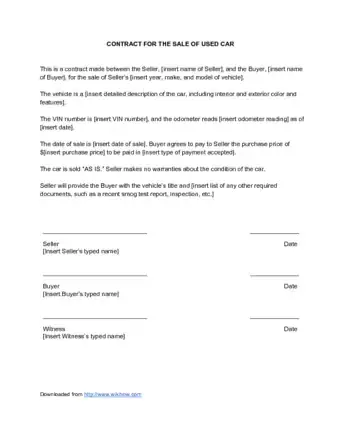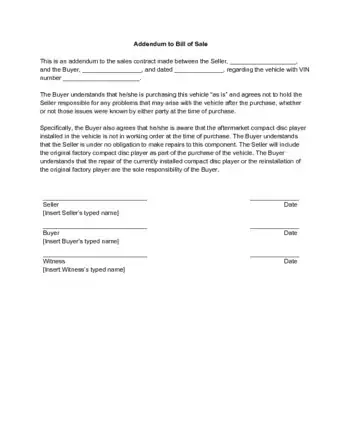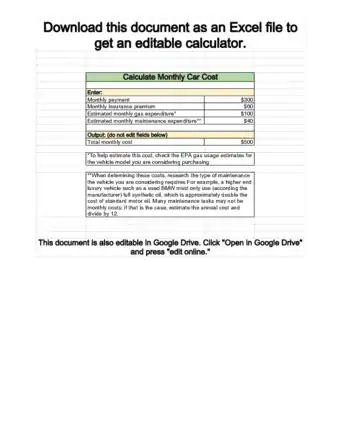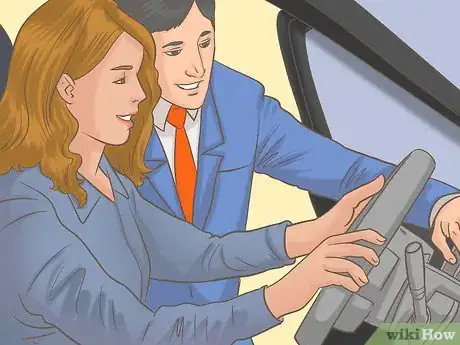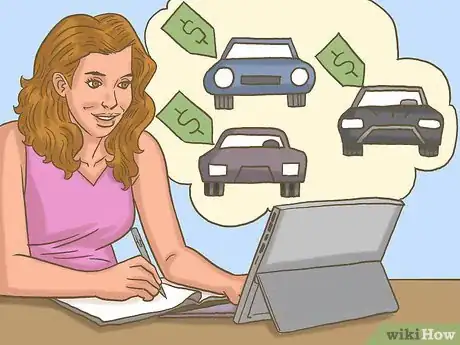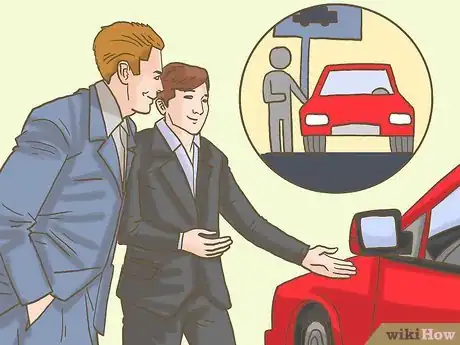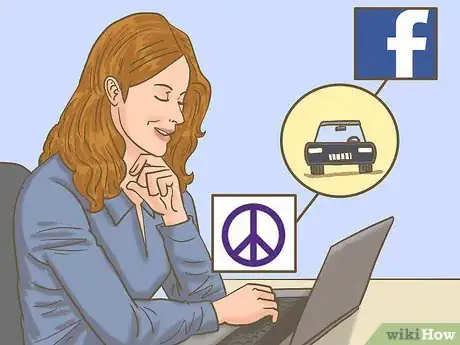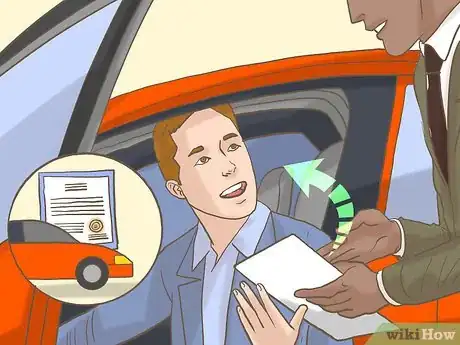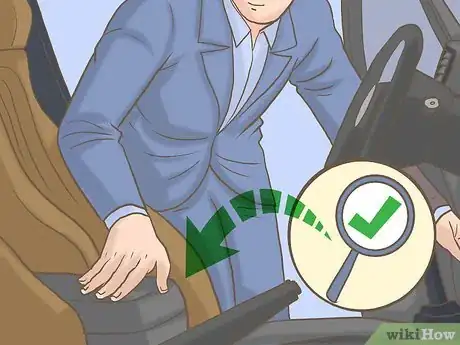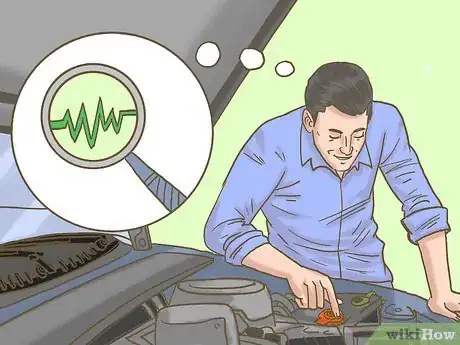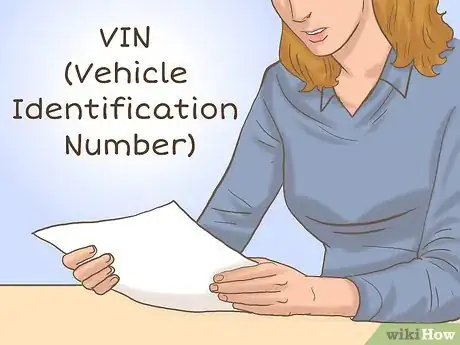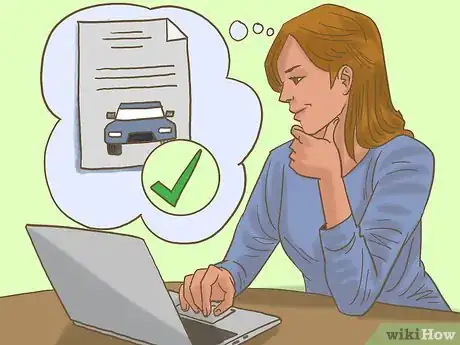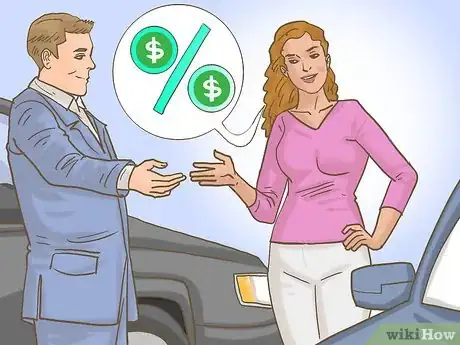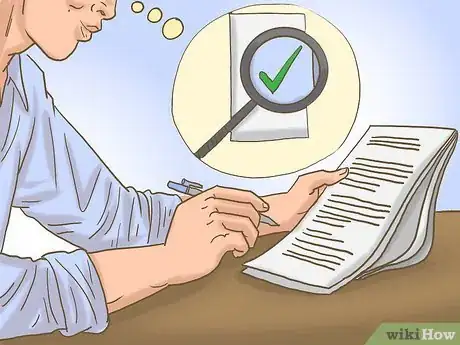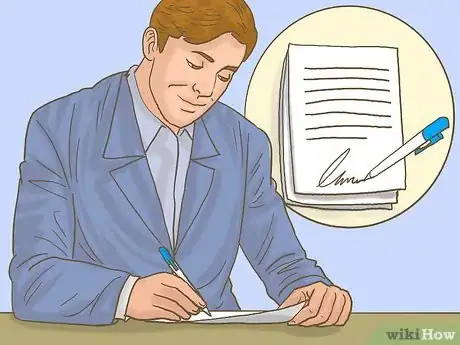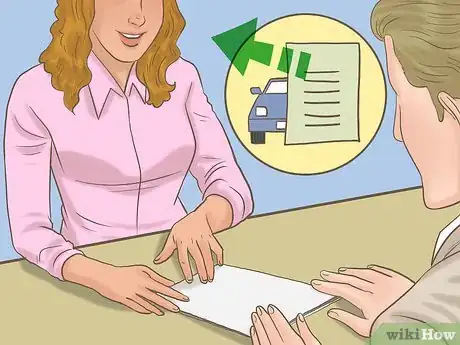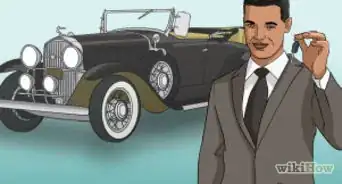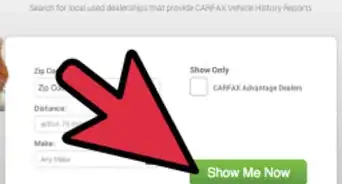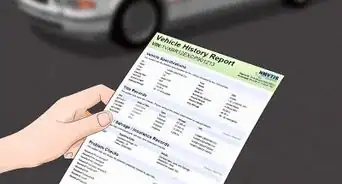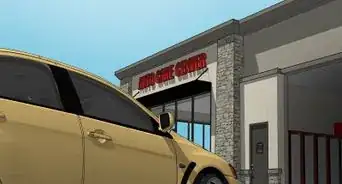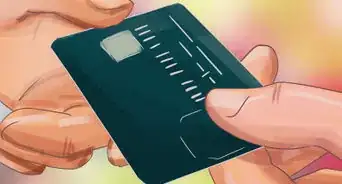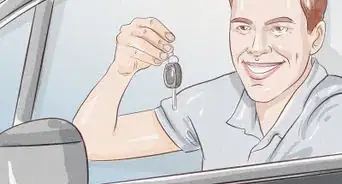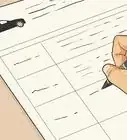This article was co-authored by Bryan Hamby and by wikiHow staff writer, Jennifer Mueller, JD. Bryan Hamby is the owner of Auto Broker Club, a trusted auto brokerage in Los Angeles, California. He founded Auto Broker Club in 2014 out of a passion for cars and a unique talent for customizing the car dealership process to be on the buyer’s side. With 1,400+ deals closed, and a 90% customer retention rate, Bryan’s focus is to simplify the car buying experience through transparency, fair pricing, and world class customer service.
There are 8 references cited in this article, which can be found at the bottom of the page.
wikiHow marks an article as reader-approved once it receives enough positive feedback. In this case, 94% of readers who voted found the article helpful, earning it our reader-approved status.
This article has been viewed 281,588 times.
Getting a new-to-you car can be exciting – especially if you're a first-time car buyer. It's also a great choice if you want reliable transportation without spending a lot of money. At the same time, buying a used car can be frustrating, especially if you don't like haggling, are on a limited budget, or don't have much time to shop around. To stay in the driver's seat, do a little research before looking at cars and have any car you want to buy inspected thoroughly before you sign on the dotted line.[1]
Steps
Sample Forms and Payment Calculator
Finding Potential Used Cars
-
1Decide how much money you want to spend. If you plan to purchase your car with cash, you already know the exact amount you can spend on a car. If you plan on financing, however, you'll need to review your budget and determine how much you can afford for a monthly payment.[2]
- The amount of your monthly payment varies depending on the term of the loan, the total purchase price of the car, and your credit score. Generally, your monthly payment shouldn't be more than 20 percent of your monthly income.[3]
- Factor in insurance premiums, maintenance, and fuel costs. Import and luxury cars generally have higher average yearly maintenance costs. Sports cars and other high-performance vehicles typically cost more to insure.
Tip: If you're planning on financing your car, you might consider applying for blank-check financing with a local bank or credit union. You'll typically get a better rate than you would if you financed through a dealership.
-
2Decide what characteristics or features you want and need. Make a prioritized list of the things you're looking for in a car, such as passenger seating, hauling capacity, legroom, and fuel efficiency. Then search manufacturer's websites for models that work best for you.[4]
- Looking at how much a car sells for new can give you some idea of what that car might cost used. For example, if you're looking at a new car that costs $20,000, you can safely assume that a 5-year-old of the same model would cost around $10,000.
Advertisement -
3Identify models in your price range that best suit your needs. Once you have an idea of the makes and models you're interested in, you can figure out the ages of those particular cars that would fit your budget. Keep in mind that different makes and models depreciate at different rates.[5]
- It's mostly the mileage (number of miles or kilometers the car has been driven) that determines the price of a used car. For example, a 2-year-old car with only 20,000 miles (32,000 km) on it would be more expensive than a 2-year-old car with 100,000 miles (160,000 km) on it, everything else being equal.
- Demand for a car can also affect the cost of used cars. For example, if you live in a mountainous area and SUVs are extremely popular, you're not likely to get a good deal on an SUV locally because sellers know somebody will eventually buy the vehicle at whatever price they want.
-
4Arrange test drives for cars you're not familiar with. Just looking at a model on a website doesn't tell you anything about how that car drives or how comfortable you'll feel driving it. If you're interested in a particular model, go out and drive one to see how it feels. You might also consider renting the car for a weekend to get an extended test drive.[6]
- Renting a car for even a single day can alert you to issues you wouldn't notice on a 10-minute test drive. It also gives you the opportunity to drive the car along your normal routes to work or school.
- If you have friends or family members who have that car, you can also ask their opinion on the car. You might even be able to drive theirs to try it out, which could save you some time and money.
-
5Start searching for your car online. Websites such as AutoTrader and CarGurus offer a wide variety of used cars that are currently for sale. You can set limits for your search such as age, mileage, and other features so your results reflect your car preferences.[7]
- You can also expand your search nationwide or search in larger regional areas to look at how local demand might affect the price of cars in your area.
- Some cars listed on these sites are for sale by individual owners, but most are listed by dealers. The contact information for the seller is included with the listing.
- There are other websites, such as Carvana and Vroom, that will sell you a car completely online and deliver it to you.[8]
Tip: Used cars listed online often sell fast. If you see a car you're interested in, contact the seller and make sure it's still available.
-
6Visit local dealerships for a broad selection of cars. Car dealerships near you often have hundreds of used cars available. In many areas, car dealerships are clustered on a single road, or in a particular part of town so you can easily visit several dealerships at one time.[9]
- Some dealers focus exclusively on used cars. New car dealerships are typically associated with a particular car manufacturer. Their used car offerings may be mostly from that manufacturer, but they'll also have other cars that customers have traded in.
Tip: It's often possible to go to a dealership and look at the cars in the lot when the dealership is closed, such as on a Sunday. You may want to do this first if you're just curious about what's available and don't want to get hassled by salespeople.
-
7Scour listings from individual sellers. There are several online forums, such as Craigslist and Facebook Marketplace, that allow owners to sell their cars directly to other people instead of going through a dealership or other middleman. You may be able to get a better deal on a car if you buy it directly from the owner.[10]
- You might also try AutoTempest. This aggregator site pulls Craigslist car ads from multiple areas so you don't have to search Craigslist multiple times. You might be able to find a better deal if you're willing and able to travel a short distance to get the car.
- Be cautious when buying directly from an individual. Bring a friend with you if you go to look at the car, and to meet the person during the day in a public place.
Evaluating the Car's Quality
-
1Get a certified used car if at all possible. Larger dealers often offer dealer-certified used cars that can take a lot of the guesswork out of buying a used car. These cars are typically only a few years old, have only had 1 owner, and have gone through a thorough inspection.
- Certified cars typically come with a limited warranty that will cover the cost of major repairs for 2 or 3 years.
- You'll likely pay a little bit more for a certified car than one of the same age that hasn't been certified. However, if you can fit it into your budget, the peace of mind may be worth spending a little more.
-
2Inspect the interior and exterior carefully for damage. Ideally, you should look in the car on a sunny day. Walk around the outside of the car and check for body damage and wear on the tires. Then check inside the car for damage to the upholstery and wear on armrests, gear shifts, and the steering wheel.[11]
- This is the time to be nitpicky. Any damages you see, no matter how small, can be used to negotiate a lower price on the vehicle.
- Consider the car's age and mileage when evaluating normal wear and tear. For example, if you're looking at a car that is 10 years old and has over 100,000 miles (160,000 km) on it, you would expect the gear shift and steering wheel to show signs of wear.
- Body damage also may be an indication that the car was wrecked and not properly repaired afterward.
EXPERT TIPBryan Hamby is the owner of Auto Broker Club, a trusted auto brokerage in Los Angeles, California. He founded Auto Broker Club in 2014 out of a passion for cars and a unique talent for customizing the car dealership process to be on the buyer’s side. With 1,400+ deals closed, and a 90% customer retention rate, Bryan’s focus is to simplify the car buying experience through transparency, fair pricing, and world class customer service.Professional Auto Broker
 Bryan Hamby
Bryan Hamby
Professional Auto BrokerLook over the car during the day to ensure you can see any issues. Bryan Hamby of Auto Broker Club says: "When you're inspecting the vehicle, check the oil to confirm it's been changed recently, and check for any sediment. Also, check all of the other fluids to make sure they're level, and make sure all of the lights work, including the brakes, turn signals, highlights, and reverse lights. You should also check the gear shifter, the electronics, the trunk and spare tire, the door locks, and the condition of the interior of the vehicle."
-
3Take the car for a test drive. It's a good idea to test drive any car before you buy it, but with used cars the test drive is essential. Use this time to make sure the engine runs smoothly, the brakes work well, and the car can turn and reverse without difficulty.[12]
- In addition to paying attention to mechanical issues, consider whether you feel comfortable in the car. You should be able to adjust the seat so that you can reach the pedals and gears and see out of all the mirrors.
Variation: If you're buying a car through an online dealer, such as Carvana or Vroom, you typically have about a week to "test drive" the car after it's delivered to you before the sale is considered final.
-
4Have the car evaluated by an independent mechanic. Even for a certified car, have a mechanic not associated with the dealership look over the car and confirm that everything is in good working order. If you don't have a specific mechanic you trust, ask friends or family members for a recommendation.[13]
- If you're buying the car directly from the owner, don't take the car to the mechanic the owner recommends. They may have a deal with the owner to downplay or fail to report serious problems with the car.
Tip: If the car needs repairs but you still want to buy it, ask the mechanic for a written estimate. You can use this information to negotiate a lower price on the car.
-
5Read over the title of the car. The car title lists information about the current owner of the car, a vehicle description, and the mileage on the vehicle. If the title is recent, the mileage listed on the title should be close (if not the same) as the mileage on the car's odometer.[14]
- Look at the VIN (Vehicle Identification Number) listed on the title. Compare it to the VIN on the car and make sure they match.
- Watch out for title brands, such as "salvage" or "flood vehicle" titles. These indicate that the car has extensive damage. Salvage vehicles cannot be registered in your name until they are rebuilt. However, even a car with a "rebuilt salvage" title isn't necessarily in drivable condition – this simply means that it has all its parts.
-
6Order the title history record for the car. A title history record tells you whether the car was ever rebuilt or salvaged, damaged in a flood, or stolen. If any of those things have happened, the car may have unseen damage or other issues that make it unsafe.[15]
- In the US, you can order a title history record from one of the vendors listed at https://www.vehiclehistory.gov/nmvtis_vehiclehistory.html. These are private companies so the cost of the report varies. Some vendors provide more detailed reports than others.
- If issues show up in the title history record but you still want to buy the car, use that information to negotiate a lower purchase price.
-
7Evaluate the car's service history report. The title history record doesn't necessarily give you all the information about how the car was taken care of by its previous owners. A service history report, available from private companies (such as Carfax) will tell you how many owners the car has had, where the car was located, whether it was involved in an accident, and what types of repairs and other service has been done to the car.[16]
- The information in these reports also impacts the final price of the car. For example, a car that has only had 1 owner, no accidents, and was serviced regularly would tend to be more expensive than an identical car that had several owners and had been involved in a couple of fender benders.
- Some dealers and individual sellers offer these reports to potential buyers for free. If it isn't offered, you might ask them if they would deduct the cost of the report from the purchase price of the car.
Finalizing Your Purchase
-
1Negotiate the price based on your evaluation and research. The price offered by the dealer or seller of a used car is almost always negotiable. Use the information you gathered when evaluating the car to try to get the price lowered. Even if you didn't uncover any major problems, you still typically have a little wiggle room.[17]
- For example, maybe the car is a great value at a fair price, but it's not the color you want. You might say something like "I am really interested in this car, I just wish it wasn't blue. This is the same color as my ex's car. Of course, if you were willing to knock a little off the price, that might be something I could get past."
- If your mechanic indicated that major repairs will be needed within the next month or so, you can use this to get a significant discount. For example, you might say "My mechanic noticed problems with the power steering and estimates $800 to repair it. So how about I pay you $7,200 instead of $8,000?"
- You can also negotiate for various add-ons instead of a lower price. For example, you might say "Since $8,000 is your final offer, would you be willing to throw in an oil change and new floor mats?"
Tip: When negotiating the price, pay attention to the total price of the car, not the amount of the monthly payments. Some used car dealers try to hook you with a low monthly payment, but after interest, you'll end up paying way more for the car than you intended.
-
2Get any return policy or warranty in writing. Most used cars are sold "as is" without any warranty at all. However, certified used cars and some others have a limited warranty. Get it in writing and make sure you understand what it covers.[18]
- Some used car dealers will tell you something like "If you have any problems within the next month, just bring it back here and we'll fix it for free." However, if they're not willing to put that in writing, you'll have no way to enforce it. If you do need to bring the car in, they'll likely claim they never said any such thing and you'll be stuck with the bill.
- If the dealer or seller offers a return policy, that should also be in writing. The dealer may say "Drive it for a week. If you decide you don't want it you can bring it back no questions asked." If that's not in writing, you may be stuck with a car you don't want.
-
3Go over the contract and other documents. When buying a car from a dealer, you'll have a stack of documents to go over and sign before you get the keys and drive away. Make sure you understand everything in these documents, and that the documents are the same as what the dealer told you.[19]
- Check for any blank spaces in the contract. Some disreputable dealers will have you sign a contract with blanks, claiming they don't want to waste your time and they'll fill them in later. Invariably, the information filled in is different from what the dealer promised you. But with your signature on the contract, there's nothing you can do about it.
- If financing is provided by the dealer, make sure you understand the interest rate and term of the loan. Find out if there are any penalties for paying off the loan early.
- If you buy your car directly from the owner, you typically won't have a formal written contract or bill of sale. However, if the owner has promised to do anything for you, make sure you get that in writing so you can enforce it in court if necessary.
-
4Sign the contract to complete your purchase. Once you're satisfied that everything in the contract is correct and you're ready to buy the car, sign and date everything. You'll likely also have to provide your driver's license and proof of insurance. Don't leave with the car until the deal is finalized. An unscrupulous dealer may let you leave with the car and later change the terms of the agreement.[20]
- You can typically add the car to your insurance before you purchase it. If for some reason you end up not going through with the purchase, you can just take it off. If you have the car financed, check the finance agreement for insurance requirements. Lenders typically require you to maintain full coverage on financed vehicles.
-
5Transfer the title and register your car. Once the sale is complete, the seller will complete information on the back of the title to transfer ownership of the car to you. You will then be responsible for paying any taxes and registering the car in your name.[21]
- If you buy the car from a dealer, they typically will take care of the title transfer and registration for you. The taxes and fees for registration and title transfer will be added to your purchase price. However, if you're buying from an individual owner, you'll need to take care of all of this yourself.
- If your car is financed, your lender will be listed as a lien holder on the title. Most lenders hold the title until the loan is paid off, then they send you a title without a lien holder listed.
Tip: If your car is being financed and you have the cash to cover the registration and fees, ask to pay these separately. There's no sense in paying interest on that amount if you don't have to.
Expert Q&A
Did you know you can get expert answers for this article?
Unlock expert answers by supporting wikiHow
-
QuestionShould I buy a used car from a dealer?
 Bryan HambyBryan Hamby is the owner of Auto Broker Club, a trusted auto brokerage in Los Angeles, California. He founded Auto Broker Club in 2014 out of a passion for cars and a unique talent for customizing the car dealership process to be on the buyer’s side. With 1,400+ deals closed, and a 90% customer retention rate, Bryan’s focus is to simplify the car buying experience through transparency, fair pricing, and world class customer service.
Bryan HambyBryan Hamby is the owner of Auto Broker Club, a trusted auto brokerage in Los Angeles, California. He founded Auto Broker Club in 2014 out of a passion for cars and a unique talent for customizing the car dealership process to be on the buyer’s side. With 1,400+ deals closed, and a 90% customer retention rate, Bryan’s focus is to simplify the car buying experience through transparency, fair pricing, and world class customer service.
Professional Auto Broker You can find better pricing if you buy from a private seller, but the vehicle is going to be sold as-is, and the seller is not required to do a vehicle inspection or provide a vehicle history report. A dealer will have a standardized inspection process, they'll provide a vehicle history report, and if you notice anything wrong with the car, you can ask the dealer to fix it. There's also a recourse process if a major issue isn't disclosed. However, there will be less room to negotiate your price.
You can find better pricing if you buy from a private seller, but the vehicle is going to be sold as-is, and the seller is not required to do a vehicle inspection or provide a vehicle history report. A dealer will have a standardized inspection process, they'll provide a vehicle history report, and if you notice anything wrong with the car, you can ask the dealer to fix it. There's also a recourse process if a major issue isn't disclosed. However, there will be less room to negotiate your price. -
QuestionHow do I get a car with poor credit?
 Community AnswerSome places specialize in poor credit loans. The good news is a car loan is a collateral loan and you are more likely to be approved for that than a regular loan. I suggest you compare interest rates and try to get the best one. Make every single payment on time so that your credit score improves and your next vehicle purchase is easier. If it is possible, I strongly suggest saving money and buying a car in full with cash, as it will save you money in interest.
Community AnswerSome places specialize in poor credit loans. The good news is a car loan is a collateral loan and you are more likely to be approved for that than a regular loan. I suggest you compare interest rates and try to get the best one. Make every single payment on time so that your credit score improves and your next vehicle purchase is easier. If it is possible, I strongly suggest saving money and buying a car in full with cash, as it will save you money in interest. -
QuestionCan I get a car title notarized at a local bank and take it to the DMV later on?
 JLuckenbillCommunity AnswerTypically, you can get it notarized first, but you should always check with your state's laws to know for sure.
JLuckenbillCommunity AnswerTypically, you can get it notarized first, but you should always check with your state's laws to know for sure.
Warnings
- This article primarily addresses buying a used car in the US or Canada. Other countries may use different terminology or have additional requirements.⧼thumbs_response⧽
References
- ↑ https://www.texasattorneygeneral.gov/consumer-protection/automotive-scams/buying-new-or-used-car
- ↑ https://www.edmunds.com/car-buying/10-steps-to-buying-a-used-car.html
- ↑ https://www.edmunds.com/car-buying/10-steps-to-buying-a-used-car.html
- ↑ https://www.edmunds.com/car-buying/10-steps-to-buying-a-used-car.html
- ↑ https://www.edmunds.com/car-buying/10-steps-to-buying-a-used-car.html
- ↑ https://www.edmunds.com/car-buying/rent-to-know-using-car-rentals-to-compare-cars.html
- ↑ https://www.digitaltrends.com/cars/best-used-car-websites/
- ↑ https://www.popularmechanics.com/cars/a16593/best-sites-to-sell-your-car-online/
- ↑ https://www.edmunds.com/car-buying/10-steps-to-buying-a-used-car.html
- ↑ https://www.popularmechanics.com/cars/a16593/best-sites-to-sell-your-car-online/
- ↑ https://www.citizensadvice.org.uk/consumer/buying-or-repairing-a-car/buying-a-used-car/
- ↑ https://www.texasattorneygeneral.gov/consumer-protection/automotive-scams/buying-new-or-used-car
- ↑ https://www.texasattorneygeneral.gov/consumer-protection/automotive-scams/buying-new-or-used-car
- ↑ https://www.roadandtrack.com/car-culture/buying-maintenance/news/a30574/everything-you-need-to-know-about-car-titles/
- ↑ https://www.txdmv.gov/motorists/buying-or-selling-a-vehicle/title-check-look-before-you-buy
- ↑ https://www.txdmv.gov/motorists/buying-or-selling-a-vehicle/title-check-look-before-you-buy
- ↑ https://www.texasattorneygeneral.gov/consumer-protection/automotive-scams/buying-new-or-used-car
- ↑ https://www.texasattorneygeneral.gov/consumer-protection/automotive-scams/buying-new-or-used-car
- ↑ https://www.texasattorneygeneral.gov/consumer-protection/automotive-scams/buying-new-or-used-car
- ↑ https://www.texasattorneygeneral.gov/consumer-protection/automotive-scams/buying-new-or-used-car
- ↑ https://www.texasattorneygeneral.gov/consumer-protection/automotive-scams/buying-new-or-used-car
About This Article
Before you buy a used car, identify the features you want your car to have and do a little research to figure out what models are in your price range. Next, search those models on Craigslist if you’re interested in buying a car directly from the owner and avoiding dealership fees. Alternatively, you can look on CarMax for used cars available at local dealerships. When you find a car you’re interested in, be sure to test drive it and get the VIN number so you can run a title check. For tips on inspecting and test driving a potential car, read on!
